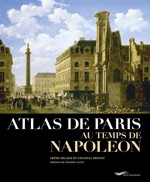Illustrated with 70 maps and drawing on 300 sources, L'Atlas au temps de Napoléon tells the story of Paris's urban evolution and the vigorous undertakings of Napoleon I, who was without a doubt the first sovereign to concern himself with both the splendour of the capital of his empire and the improvement of the living conditions of its inhabitants. His legacy is impressive: Napoleonic Paris is embodied by the Arc de Triomphe on the Champs-Elysées and the Arc de Triomphe du Carrousel, the Vendôme column, the Bourse, the Musée Napoléon (i.e., the Louvre), but also in the reorganisation of the quays and the construction of the bridges (the Ponts d'Iéna, des Arts and d'Austerlitz), the Canal de l'Ourcq and the network of public fountains, the covered markets, the cemetery of Père Lachaise. Here, authors Irène Delage and Chantal Prévot shed valuable light on some of these projects.
(Interview 5 September, 2014)
Napoleon.org: What were the biggest urban issues facing Napoleon and the municipal authorities?
Irène Delage: There had been a number of urban improvements in Paris over the course of the eighteenth century (the construction of a major sewer, improvements to the quays, the closure of the city's intra-muros cemeteries), but these hardly touched on the big urban issues. In 1800, Paris was still a maze of narrow dirty streets, and it remained a city with very limited possibilities for construction given its densely packed urban fabric (particularly in the historic city centre), and with terrible sanitary conditions (made worse by its population density and slums). What's more, up to this point no plan had conceived of the city as a whole: any improvements, whether for utilities, leisure or aesthetic reasons, were generally the response to one particular problem.
The French Revolution was an important turning point for the urban history of Paris. With the decree of 2 November 1789 about the property of the clergy, and the auctioning off, from July 1792, of émigré property that had been confiscated in March 1792, there were suddenly around 400 hectares of land available in the capital, which permitted the planning of subdivisions, the opening of new routes for circulation… This was even more important when you consider that the Parisian population would increase by more than 13% under the Consulate and Empire.
Napoleon.org: Which were the improvements that most improved the daily life of Parisians?
Chantal Prévot: I would give first place to the development of the water supply network and to the creation of the city's fountains, then the construction and renovation of the food markets. The creation of abattoirs around the end of the city and the enlarging of the sewer system for hygiene reasons were less spectacular, but still very important. Not to mention a major milestone: the practical and logical numbering of houses throughout the city to be able to identify them with ease, a system we still use today.
Napoleon.org: What were Parisians' favourite pastimes? Who could take part?
Chantal Prévot: There were a huge number of different leisure activities. Parisians were, and still are, gawkers who loved to wander in the streets and watch entertainment. Dramatic performances were a passion that could be enjoyed in the theatres and along the boulevards. Jugglers and bear-trainers also occupied these areas of leisure. Panoramas, huge rooms with circular paintings that gave the impression of being at the heart of the action, were exciting novelties that drew a huge public. The so-called pleasure gardens (really these were theme parks avant la lettre) also welcomed both the Parisian elite and more modest audiences. In the summer there were swimming pools, too, and ice skating rinks in the winter.
Napoleon.org: In contrast to leisure, what changes took place for work and both industrial and artisanal activities under the Empire?
Irène Delage: The textile industry remained a major employer (by 1811 there were 57 spinning mills and 13,000 workers) benefiting from the new spaces made available by the sale of national property and developing large factories. Practices improved with the arrival of English machine producers, such as the Cellier brothers in the Marais. The continental blockade was an important factor, of course, in this activity. Beyond questions of economic vitality, Paris was also confronted with the problem of pollution with the development of chemical industries, like the production of soda necessary for many industries (paper making, dyeing, glasswork, tanning). Complaints grew more numerous, and an order from the Préfet de Police in 1806 was reinforced by the decree of 1810 which classed manufacturers by three categories according to their dangerousness and obliged them to meet set regulations (such as building their works far from residential areas). This was a major step, even if, in reality, things moved very slowly and many polluting activities, such as those around the neighbourhood of La Bièvre, continued after the Empire.
The authors: Irène Delage is the Head of Documentation at the Fondation Napoléon. Chantel Prévot is the librarian in charge of the same institution.


